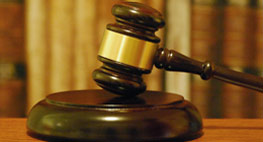Bong goes the court in free-speech ruling
Lawyer Blogs
[##_1L|1333342306.jpg|width="104" height="138" alt=""|_##]The U.S. Supreme Court needlessly chipped away at First Amendment free-speech guarantees with a ruling elevating a high-school prank to a dangerous promotion of drug use. The 6-3 ruling miscast the case before the court as about drugs. But it was about a student's right to speech. Five years ago, high-school senior Joseph Frederick stood across the street from his school and unfurled a 14-foot banner that read "Bong Hits 4 Jesus." Frederick and other students from the Juneau, Alaska, school were just off school property attending a nonschool event, an Olympic Torch relay.
Frederick's sign was ambiguous. Was the 18-year-old supporting drugs or Christianity? The ambiguity matters because it places Frederick's sign within the confines of protected speech.
Supreme Court members, in a majority opinion written by Chief Justice John Roberts, convinced themselves that Frederick's banner was a public promotion of the use of illegal drugs. School authorities, according to Roberts — joined by Justices Thomas, Scalia, Alito and Kennedy — did not violate Frederick's constitutional rights when they went across the street, snatched his sign and ripped it to shreds.
The Supreme Court recognized student political speech with its 1969 decision, Tinker v. Des Moines (Iowa) School District. Justice Stephen Breyer, while siding with the majority, asserts that Frederick and his bong-hits banner make for an inadequate foundation on which to limit students' right to political speech.
The court's dissenters - Justices John Paul Stevens, David H. Souter and Ruth Bader Ginsburg - go further. Stevens, penning the dissent, called the student's banner "nonsense" and the court's ruling a reach for broad censorship that would ban speech that advocated for medicinal marijuana use or other related messages.
The majority worries that illegal drugs are a serious danger in schools. This argument gets some sympathy but not enough to trample on the First Amendment.
Related listings
-
Court Finds Missing Pants Not Worth $54M
Lawyer Blogs 06/25/2007A judge in the District of Columbia has dismissed a case against a dry cleaner that claimed $54 million in damages for a pair of missing pants. The case was brought by Roy L. Pearson, himself a judge. He originally sought $67 million from the Chung f...
-
Supreme Court Rules in "Bong Hits 4 Jesus" Case
Lawyer Blogs 06/25/2007The Supreme Court ruled Monday in the “Bong Hits 4 Jesus” case that schools do not violate a student’s First Amendment free-speech rights by punishing speech that appears to promote drugs at a school-sponsored event. The Court reversed the Ninth U.S....
-
Legal Battle Looms Over Tacoma Billboards
Lawyer Blogs 06/25/2007Ten years ago, the City of Tacoma adopted strict new rules limiting the size and placement of billboards. Nothing bigger than 300 square feet. Nothing closer than 250 feet to a residential area, church or school, historic district, playground or park...

Illinois Work Injury Lawyers – Krol, Bongiorno & Given, LTD.
Accidents in the workplace are often caused by unsafe work conditions arising from ignoring safety rules, overlooking maintenance or other negligence of those in management. While we are one of the largest firms in Illinois dedicated solely to the representation of injured workers, we pride ourselves on the personal, one-on-one approach we deliver to each client.
Work accidents can cause serious injuries and sometimes permanent damage. Some extremely serious work injuries can permanently hinder a person’s ability to get around and continue their daily duties. Factors that affect one’s quality of life such as place of work, relationships with friends and family, and social standing can all be taken away quickly by a work injury. Although, you may not be able to recover all of your losses, you may be entitled to compensation as a result of your work injury. Krol, Bongiorno & Given, LTD. provides informed advocacy in all kinds of workers’ compensation claims, including:
• Injuries to the back and neck, including severe spinal cord injuries
• Serious head injuries
• Heart problems resulting from workplace activities
• Injuries to the knees, elbows, shoulders and other joints
• Injuries caused by repetitive movements
For Illinois Workers’ Compensation claims, you will ALWAYS cheat yourself if you do not hire an experienced attorney. When you hire Krol, Bongiorno & Given, Ltd, you will have someone to guide you through the process, and when it is time to settle, we will add value to your case IN EXCESS of our fee. In the last few years, employers and insurance carriers have sought to advance the argument that when you settle a case without an attorney, your already low settlement should be further reduced by 20% so that you do not get a “windfall.” Representing yourself in Illinois is a lose-lose proposition.

